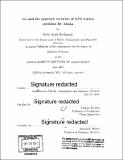Ice and the apparent variation of GPS station positions for Alaska
Author(s)
Kochanski, Kelly Anne
DownloadFull printable version (6.989Mb)
Alternative title
Ice and the apparent variation of Global Positioning System station positions for Alaska
Other Contributors
Massachusetts Institute of Technology. Department of Earth, Atmospheric, and Planetary Sciences.
Advisor
Thomas Herring.
Terms of use
Metadata
Show full item recordAbstract
Most GPS stations in Alaska show apparent seasonal variations on the order of one centimeter. The majority of these stations move downwards throughout the winter, a motion which is in phase with regional snowfall and has been attributed to hydrological loading (Fu et. al., 2012). The range of phases across the state, however, spans half the year and does not correlate with snow patterns. Six stations show discontinuous seasonal variations on the order of 1-10cm. After examining the geography and windspeed at these sites, we conclude that at least three of them will accumulate rime ice during the winter, and that this ice can cause apparent upwards motions of the stations. This hypothesis is supported by seasonal variations in the stations' multipath values, which indicate increased signal scattering during the winter.
Description
Thesis: S.B., Massachusetts Institute of Technology, Department of Earth, Atmospheric, and Planetary Sciences, 2015. Cataloged from PDF version of thesis. Includes bibliographical references (pages 49-50).
Date issued
2015Department
Massachusetts Institute of Technology. Department of Earth, Atmospheric, and Planetary SciencesPublisher
Massachusetts Institute of Technology
Keywords
Earth, Atmospheric, and Planetary Sciences.